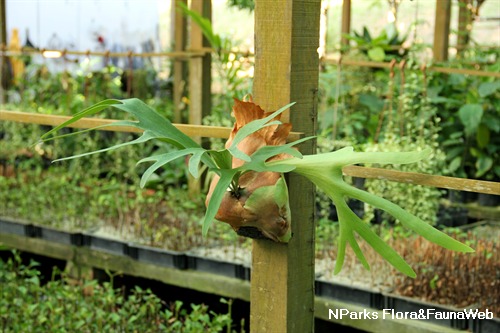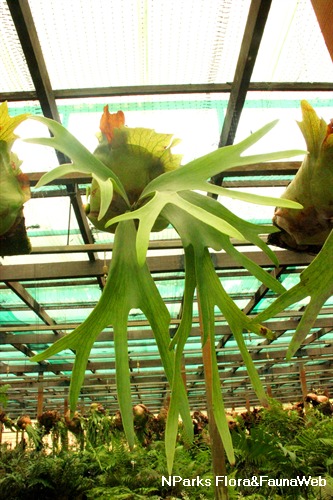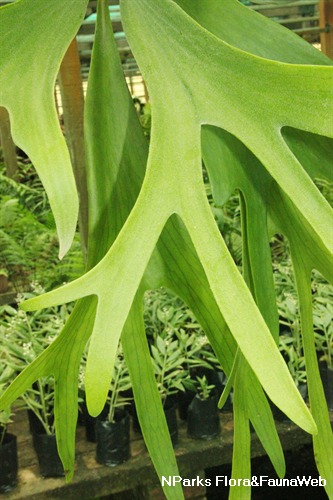
Back
Platycerium bifurcatum (Cav.) C. Chr.
| Family Name: | Polypodiaceae |
| Common Name: | Elkhorn Fern, Common Staghorn Fern |
Name
Classifications and Characteristics
| Plant Division | Ferns & Lycophytes (Non-Seed Vascular Plants) (Fern) |
|---|---|
| Plant Growth Form | Epiphyte |
| Mode of Nutrition | Autotrophic |
Biogeography
| Native Distribution | Java, New Guinea, Australia (Queensland and New South Wales) |
|---|---|
| Native Habitat | Terrestrial |
| Preferred Climate Zone | Tropical |
| Local Conservation Status | Non-native |
Description and Ethnobotany
| Growth Form | Epiphytic fern with a short rhizome, usually found growing on trees, able to grow up to 1 m long. |
|---|---|
| Foliage | 2 types of fronds, both sterile and fertile fronds, sterile fronds are heart-shaped and measures about 12 - 45 cm long, fertile fronds are fork-shaped and measures about 90 cm long. Spores are found on the underside of the tips of the fertile fronds. |
| Etymology | Genus epithet Platycerium derived from Greek terms 'platys' (broad) and 'keras' (horn), a reference to the antler-like nest-fronds. Species bifurcatum means divided into equal parts. |
Landscaping Features
| Desirable Plant Features | Ornamental Foliage |
|---|
Fauna, Pollination and Dispersal
| Seed or Spore Dispersal | Abiotic |
|---|
Plant Care and Propagation
| Light Preference | Semi-Shade |
|---|---|
| Water Preference | Moderate Water |
| Propagation Method | Spore |
Foliar
| Mature Foliage Colour(s) | Green, Green - Light Green |
|---|
Image Repository
Others
| Master ID | 30267 |
|---|---|
| Species ID | 4576 |
| Flora Disclaimer | The information in this website has been compiled from reliable sources, such as reference works on medicinal plants. It is not a substitute for medical advice or treatment and NParks does not purport to provide any medical advice. Readers should always consult his/her physician before using or consuming a plant for medicinal purposes. |







